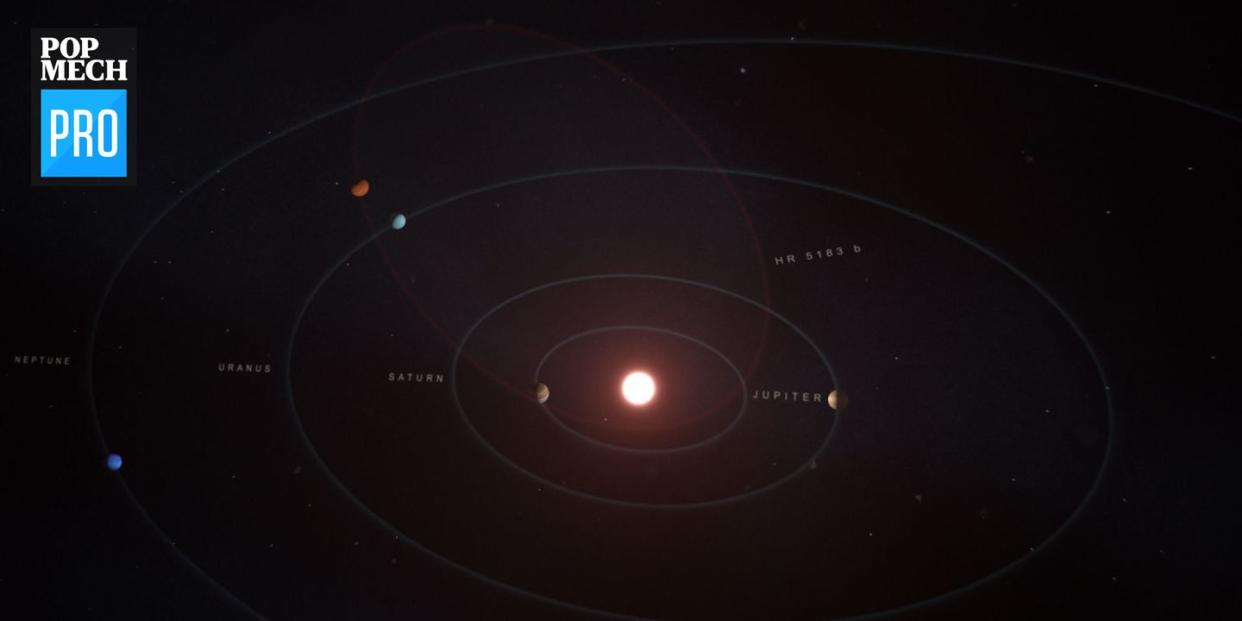This Exoplanet Has the Weirdest Orbit We've Ever Seen

The planet, HR 5183b, takes 77 years to complete an orbit. But that orbit is extremely eccentric, spanning essentially the equivalent of Jupiter's orbit at its closest point to its home star, and past Neptune at its furthest. The orbit is "comet-like."
The planet, which is about 102 light years away, likely got this way in an incident that ejected another planet in the system.
It's both one of the longest orbital periods known, and one of the most eccentric.
We know of 4,043 planets outside our solar system. Of those, a small handful could be considered weird. And now there's a new member to that strange planetary pantheon: HR 5183b.
First, there's its size: It has the more mass than three Jupiter-size planets put together. But we've come across high mass planets before, up to the 13 Jupiter limit between planets and a class of object called brown dwarfs. It also has an extremely long year, circling its sun-like home star in 77 years. That's an entire human lifetime, and makes it easily in the top 10 longest planetary orbits yet detected.
But what makes HR 5183b go from "a little different" to "truly weird" is its orbital path. If you were to overlay it in our solar system, it would sweep in as close as Jupiter and as far out as Neptune in that 77-year span. It's covering the distance, in other words, of the entire outer solar system.
It also thus far seems to be alone out there. But that could be part of its origin story.
"This is definitely a first-of-its-kind planet," says Sarah Blunt, a Caltech NSF graduate fellow and coauthor of a new paper about HR 5183b. "It’s very eccentric—it’s almost in a comet-like orbit. In our solar system, comets tend to have pretty eccentric orbits, but planets tend to be very circular, with very low eccentricity."
In the paper, accepted for publication in The Astronomical Journal, the researchers outline this new weird world. They had been looking at the parent star, HR 5183, for more than 20 years, stretching back to the days of the earliest exoplanet discoveries.
Blunt said that up until five years ago, there were scant signs of a planet in the system. The researchers were looking for changes in the radial velocity of the star. Essentially, in this process, you look at the breakdown in light—or spectra—of the star. You can detect planets using this method by waiting to see if something pulls the light toward or away from the observer. A rough mass estimate can be derived from this, as well as an idea of orbital period.
But HR 5183b might have gone unnoticed had it not had such a sharp tug on its star. As it ends up, when the researchers began to notice the radial velocity changes, they were capturing the planet nearing its closest approach to the star. In other words, it was only in the "right" region of space in that time frame for astronomers to capture it.
Blunt says that originally the planet may have started with a roughly circular orbit, like our planets. But in an effect she calls the "planet pinball theory," it got gravitationally caught up with another planet in the system. In the ensuing tussle, HD 5183b ended up with a long year while the other planet got flung out completely.
So far, HR 5183b seems to be the only thing larger than Neptune out there, save a star about 15,000 times the Earth-Sun distance away from the home star. (The sensors used to detect the planet can only go down to about 12 Earth-mass.) At that distance, its influence is too scarce to have an effect on the planet. Though that star may not have always been at that distance as well, a possible fold in the origin story.
Future observations of the planetary system could yield a few answers. For instance, ESA's Gaia mission may turn up evidence of further out planets, while direct imaging efforts could help astronomers see the planet itself.
Whatever they turn up, though, could run the risk of just making the planet weirder than it is right now.
You Might Also Like

